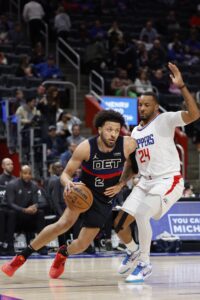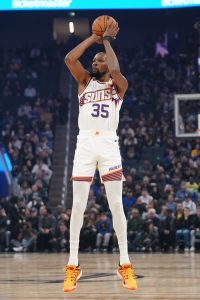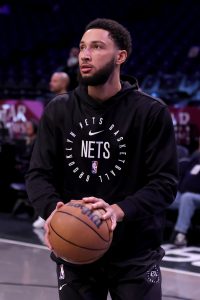After finishing second in Defensive Player of the Year voting as a rookie in 2024, rising Spurs star Victor Wembanyama was viewed at this year’s All-Star break as the overwhelming frontrunner to win the award in his second NBA season.
However, the All-Star Game is the last game that Wembanyama will play in 2024/25, as he was ruled out for the remainder of the season after being diagnosed with a deep vein thrombosis in his right shoulder. While the Spurs do everything they can to make sure their franchise player is healthy and ready to go for the 2025/26 season, this year’s Defensive Player of the Year award is suddenly very much up for grabs.
Wembanyama will soon be officially out of the running, since he’ll fall well short of the 65-game requirement for end-of-season awards. As we wrote on Saturday, his absence has made Jaren Jackson Jr. of the Grizzlies and Evan Mobley as the Cavaliers the clear betting favorites to win Defensive Player of the Year.
The two young big men squared off on Sunday for the first time this season, with Mobley leading the Cavs to a tight victory by racking up 25 points, 13 rebounds, eight assists, and three blocked shots. For the season, Cleveland has a 106.9 defensive rating with Mobley on the court and a 112.6 mark when he’s not. Although Cleveland’s defense ranks seventh overall, that 106.9 defensive rating when Mobley plays would be second-best in the NBA.
Jackson, the NBA’s Defensive Player of the Year in 2023, has had a very similar on/off-court impact in Memphis. The Grizzlies have a 106.8 defensive rating when Jackson is on the floor and a 113.1 mark when he sits.
Mobley and Jackson are anchors of their respective defenses but have the athleticism and versatility to switch onto smaller opponents and move away the basket if necessary. Another player with that skill set is Heat big man Bam Adebayo, who has finished in the top five of Defensive Player of the Year voting in each of the past five seasons.
Asked last week about the possibility of a DPOY award, Adebayo made it clear he’s more focused on getting the Heat back on track than earning individual hardware. He may need to do the former to have a shot at the latter, since team success is a major factor in award consideration. Miami currently ranks eighth in the Eastern Conference with a 26-29 record.
While voters typically favor centers who protect the basket, a wing or forward can emerge as a leading candidate when no one big man separates himself from the field. Thunder swingman Luguentz Dort, a lock-down defender on the wing, could become that player this season. Oklahoma City’s 104.8 defensive rating leads the league by a wide margin and Dort currently has the third-best DPOY betting odds at BetOnline.ag.
Asked by Chris Mannix of SI.com last week about his individual goals beyond winning a championship, Dort acknowledged that he’d love to be recognized for his defense.
“Honestly, the biggest goal is to go out there and perform every night for my teammates,” he said. “But it will always be nice to get rewarded for the hard work that I do on the court, which would probably be Defensive Player of the Year or (All-Defensive) first team. If you ask me if I deserve it, I would say yes, just because of what I bring every night, all the matchups that I got to face every night. But all that would be a goal of mine.”
Dort’s teammates Shai Gilgeous-Alexander and Jalen Williams, rising defensive stars Dyson Daniels and Amen Thompson, and four-time DPOY Rudy Gobert are among the other betting options available at BetOnline.ag, but I’d view them as longer shots.
We want to know what you think. Which player would be your 2024/25 pick for Defensive Player of the Year? Which player do you expect to win the award? Would Wembanyama have been your choice if he had reached the minimum-game threshold?
Head to the comment section below to weigh in with your thoughts!
 Cunningham is the current favorite for the award, but Powell is a close second.
Cunningham is the current favorite for the award, but Powell is a close second.  That changed in the days leading up to last Thursday’s trade deadline, when rumors began percolating about Durant’s possible availability. While the former MVP ultimately stayed put,
That changed in the days leading up to last Thursday’s trade deadline, when rumors began percolating about Durant’s possible availability. While the former MVP ultimately stayed put,  The NBA’s buyout market has been active since the trade deadline and could feature several more moves in the next couple weeks.
The NBA’s buyout market has been active since the trade deadline and could feature several more moves in the next couple weeks.